EUGENE PARKS AND OPEN SPACE ANNUAL REPORT
 Riverfront Park
Riverfront Park

 Eugene Parks and Open Space 3
RiverPlay Discovery Village Playground
Eugene Parks and Open Space 3
RiverPlay Discovery Village Playground
 Golden Gardens Park
Golden Gardens Park

 Riverfront Park
Riverfront Park

 Eugene Parks and Open Space 3
RiverPlay Discovery Village Playground
Eugene Parks and Open Space 3
RiverPlay Discovery Village Playground
 Golden Gardens Park
Golden Gardens Park
Welcome to the inaugural edition of the City of Eugene’s Parks and Open Space Annual Report. The division was established twenty years ago with the purpose of stewarding the public parks, natural areas and urban forests managed by the City of Eugene. Over the years, these areas have diversified to also include waterways, wetlands, medians and rain gardens.

This report shares highlights from Fiscal Year 2021-2022 and our vision of beautiful, inspiring places that foster personal, community and environmental health. I’ve been lucky enough to spend the last decade as the director of this division and believe the next decade will be a time of tremendous challenge and opportunity. Building resilience and equitable service into our operations are two ways we can be better prepared to meet whatever the future might bring.
Resilience includes working to establish integrated climate adaptation strategies to make our parks and natural areas stronger in the face of more extreme weather conditions and wildfires. This also includes making sure our extraordinary staff are well-trained and prepared for these shifting conditions.
Providing equitable services is about applying a fairness lens to system-wide operations, programs and services by committing to understanding diverse perspectives. We want to look at all the ways we can ensure access for all to parks and open spaces, and not perpetuate barriers that have historically led to unfair and unequal access to these spaces. We are also working on building meaningful partnerships with community members and engaging multiple perspectives when planning projects to ensure the spaces and programs we provide address the needs of all segments of the community.
Together we are better positioned to meet the challenges and opportunities our community faces. We appreciate your ongoing support and investment in this beautiful park system. Parks and open spaces are essential to our life, health and well-being. We must continue to work together to ensure these green spaces are protected and accessible for present and future generations.
Thank you,
Craig Carnagey Division Manager, Parks and Open SpaceOur daily and long-term strategic work is guided by four core principles:
• Care for and make the most of what we have
• Serve the entire community
• Create more connections
• Build better partnerships
• Be Safe – Safety is paramount. We work every day to make our workplace, parks and open spaces safe for staff and the community.

• Be Well – Actively engage in ways to make our workplace, parks, open spaces and community vibrant, healthy and inviting.
• Be a Team – Build unity and work together for success. Blur the lines, remove barriers, rely on expertise, encourage playfulness and celebrate wins.
• Be Resourceful – Foster strategic partnerships to leverage resources and maximize efficiencies. Be resilient in an ever-changing world, remain steadfast in preserving Eugene’s exceptional quality of life.
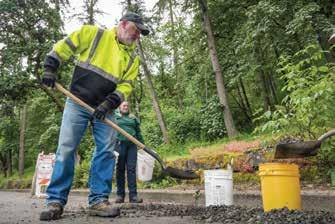

• Be Innovative – Aim high. Combine the best of public policy, technology, science and new ideas to deliver the highest quality services and experiences possible.
• Be Ambassadors – We are advocates for the value of healthy green spaces. Share our stories, build relationships and engage the community in meaningful ways.


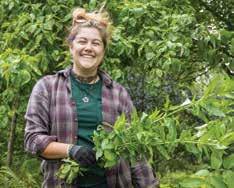

Community and Administrative Services $3,015,379 Green Infrastructure $1,470,429 Park Planning, Development $1,206,693 Park Operations and Maintenance $13,137,897 Capital $12,783,010
Total Division Budget $31,613,408
General Fund (general, misc rev) $91,752 Operating Road Fund (parking, street trees) $26,800 Stormwater Fund (fees, grants) $601,717 Wetland Mitigation Fund $632,532
Total Budgeted Revenue $1,352,801
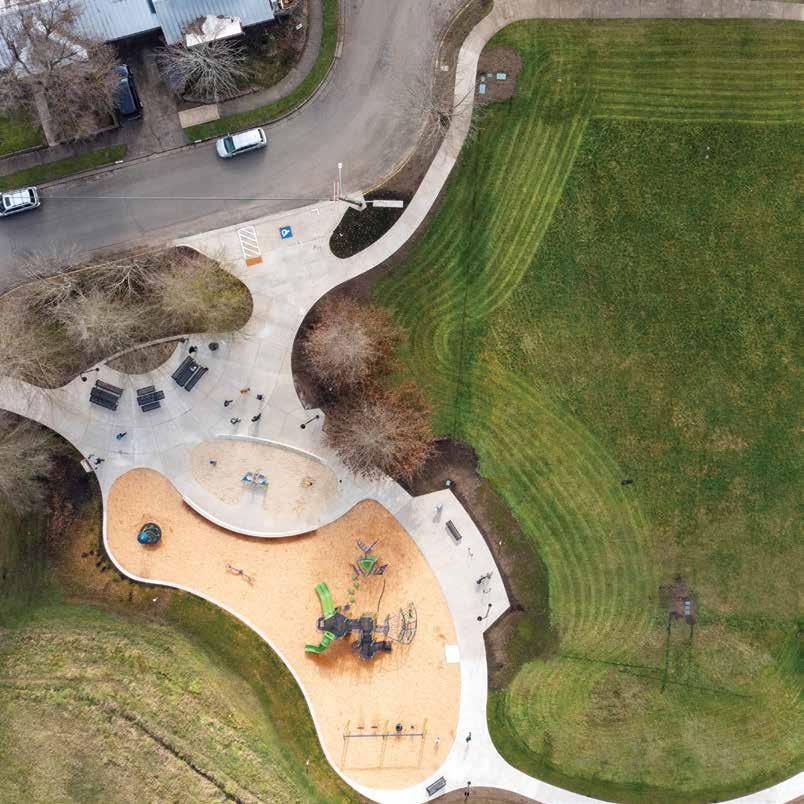 Berkeley Park
Berkeley Park
 Mangan Park Playground
Mangan Park
Mangan Park Playground
Mangan Park
Community engagement is at the core of everything we do. From public planning meetings to concerts in parks to volunteer events and park rentals, we try to provide a multitude of ways for people to get involved and help make decisions about the future of the park system.
In the summer of 2022, the Turell Group helped us conduct a survey to better understand how community members view their parks and the improvements made possible through the 2018 Operational Levy.
Throughout this report, we’ll share additional statistics and quotes from the annual survey.
Of 1,260 respondents, 89% of respondents indicated that parks are ‘extremely’ or ‘very-important’ to their quality of life. Additionally, people indicated that they feel the 2018 Parks Levy is worth the additional cost to taxpayers.
Park Watch helps make our parks safer with easy mobile reporting for information related to safety and maintenance issues.
In FY22, we received 2,547Park Watch reports.
Over 400 garden plots in six parks provide gardeners space to grow their own food and connect with community. In FY22, long-deferred maintenance on perimeter fences began with a replacement fence at the Whiteaker Community Garden. Additional fence improvements and irrigation maintenance are coming soon.
 12 Eugene Parks and Open Space
12 Eugene Parks and Open Space
Public involvement is a critical piece of our work. Parks planning staff held several outreach meetings in FY22 on topics ranging from the new Downtown Riverfront Plaza to existing park renovations and new mountain bike trails.

The park system thrives with the support of a vibrant network of volunteers of all ages and backgrounds. In FY22, volunteers contributed over 22,000 hours at public events.
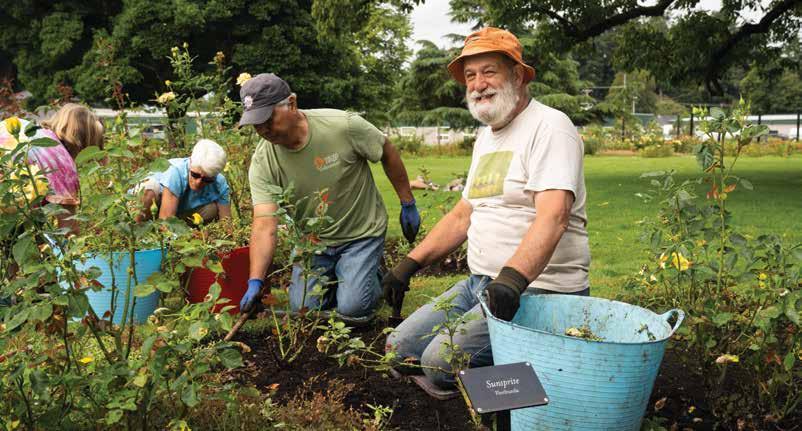
Eugene’s parks sit within a larger context of public and non-profit agencies, recreation providers and land owners. This web of agencies and service providers is critical to meeting the needs of the community and region. Some of these partners include:

• The Eugene Parks Foundation works to enhance parks and recreation across the city. In FY22, they helped parks purchase new acreage of natural areas and are working on the creation of four new trails. In addition, they have launched The Parks We Treasure capital campaign that will bring spray play areas to parks in underserved neighborhoods, build exercise stations, and create a world-class nature play playground.
• Friends groups like the “Friends of Hendricks Park” provide additional funding for seasonal staff, invasive species removal and aesthetic pruning. Other donors and private funds maintain trails and plant trees.
• Across the system, we have more than 150 partner organizations committed to helping us care for our parks and natural areas.
We continue to expand the City’s collection of art in parks including “SubSupra,” and “Culture Raising,” at the Downtown Riverfront Park, as well as new murals at Westmoreland Park and the Owen Rose Garden.
“Eugene has such a variety of parks and open spaces. They are a treasure that all of us should help preserve.”

Parks and Recreation Services staff spent a combined 400 hours completing part one of a National Recreation and Parks Association health-focused racial equity training. Staff deepened their skills in racial self-awareness, cultural literacy and changing trends in our work environment. Staff who completed part one will continue on to an agency-wide assessment this fall, while remaining staff begin the self-assessment.
“Taking time to reflect on ourselves as both individuals and as part of a public agency is important work we must do to make sure that we truly are serving our community holistically and equitably.”
– Josiah SheehanWe know that Eugene’s public spaces have too often been white-centered and exclusionary to historically marginalized groups. Parks staff have convened a Black Advisory Committee to advise on upcoming projects with the goal of making parks more inclusive. The new committee met several times in FY22 and provided support on the upcoming Martin Luther King Jr Park renovation and the development of Mattie Reynolds Park.
As part of the design process for the Downtown Riverfront Park, Parks engaged a Black community focus group to assist with the interpretation of the “Across the Bridge” story. Across the Bridge refers to Eugene’s first Black community located in and around the current Alton Baker Park, from which they were forcibly removed in 1949. A new art piece in the shape of a multi-level drinking fountain will tell their story while sharing a message of inclusivity into the future. This piece will be installed in 2023.


Illustration of the “Across the Bridge” interpretive artwork
This ArtCity collaborative project celebrates local indigenous communities through a collection of larger-than-life portraits of elders and younger members of local tribes taken by a local artist. Prior to the Downtown Riverfront Park opening, the City hosted a first indigenous-centered community event to tour the new park and discover the work.
Upcoming playgrounds and splash pads at Striker Community Park, Santa Clara Community Park and Mattie Reynolds Park will include fully accessible surfacing and other inclusive playground elements.
 18 Eugene Parks and Open Space
Amazon Park Playground
18 Eugene Parks and Open Space
Amazon Park Playground
In 2018, Eugene voters overwhelmingly passed a five-year capital bond and operating levy to sustain and improve our parks. In FY22, Parks staff continued to oversee the completion of new parks and major renovations at existing parks with the use of bond funds. Of the 37 bondfunded projects, 28 (75 percent) are complete or underway.


“Thank you for all you do! My husband and I picked up a map of all the Eugene parks and have been slowly working our way through visiting all of them. I’ve lived here for more than 30 years and it’s like rediscovering our town all over again. There are so many neat parks here!” – Survey Comment
This park renovation included an expansion of the playground and installation of all new equipment, small sand play area and informal nature play area. The renovation also expanded the lawn and included burial of overhead utility lines, new tree planting and an accessible looped path. The renovated park opened in February 2022.
“Thanks so much for all the city has done in the design and upgrade of our Berkeley Park. I love that you were inclusive of the neighbors in the design process. So appreciated!!” – Survey Comment

A short easement across private property was acquired in July 2022 allowing the project to move forward. Creating a loop out of this popular out-and-back trail in the middle of town is now scheduled for construction in 2023. Funded in part by a $350,000 OPRD Local Government Grant, the project includes a new pedestrian bridge and an improved neighborhood connection.
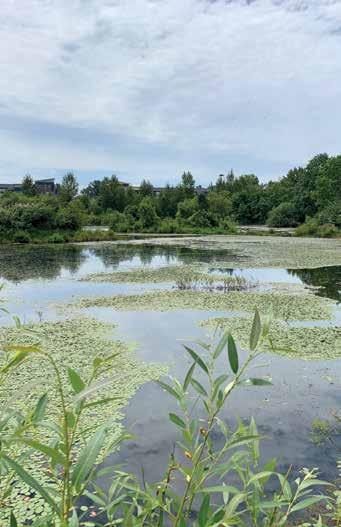 20 Eugene Parks and Open Space
Berkeley Park Delta Ponds
20 Eugene Parks and Open Space
Berkeley Park Delta Ponds
After three years of preparation, and upon completion of new park features including paths, landscapes and art installations, the Downtown Riverfront Park opened to the public in June 2022. It subsequently hosted the Eugene Riverfront Festival in tandem with the World Athletics Championships at Hayward Field in July. An estimated 37,000 visitors came to the park during the 10-day festival.


New lighting projects to improve paths were completed at Alton Baker, the South Bank path, and Monroe Park. In each project, we invested in new, longer lasting fixtures with efficient LED lighting and designed the systems to minimize impact to night skies and the surrounding habitats or neighborhoods. Fern Ridge Path lighting improvements are planned for construction in 2023.
This small, less than one-acre urban park is tucked into the Far West neighborhood. A public engagement process that began in May 2022 is helping to refine Parks goals around renovation, activations and community art opportunities. Construction is scheduled for 2024.

This 5.25-acre park located in the Churchill neighborhood will be the first newly developed park in the southwest planning region in over 15 years. It is named for the matriarch of one of the first Black families to settle in southwest Eugene after being displaced by construction of the Ferry Street Bridge. Public engagement began in 2022 with construction planned for the summer of 2025.

These projects focus on removal of invasive species and reduction of heavy vegetation to reduce wildfire hazards. Ongoing work at Ridgeline sites treat highly invasive weeds that disrupt native ecosystems. On Skinner Butte’s south slope, hundreds of native plants were planted to create a more diverse understory that benefits wildlife and improves soil stability.
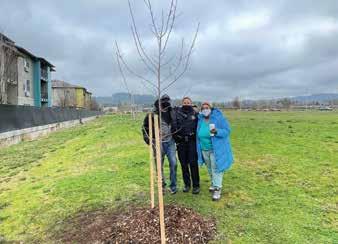 22 Eugene
Martin Luther King Jr. Park
Mattie Reynolds Park
Skinner Butte Park
22 Eugene
Martin Luther King Jr. Park
Mattie Reynolds Park
Skinner Butte Park
Renovations to the Monroe Park restroom were scoped and designed with the goal of making this seasonal facility accessible and open to the public year-round. Project construction is expected to be complete in fall of 2022.

Phase one of development includes a large playground, restroom, parking lot, community gathering space, picnic shelter, open lawn and tree planting as well as paved and soft-surface walking paths. Construction is anticipated for the summer of 2023 with the park opening in 2024.
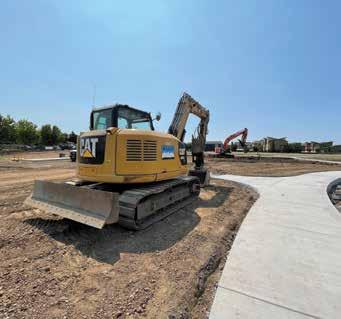
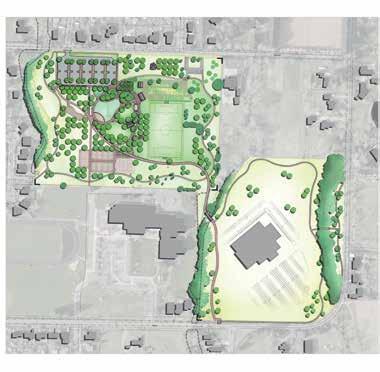
This eight-acre park site will serve the recreational needs of northeast Eugene with a large playground, restrooms, picnic shelter, spray play, walking paths, open lawn, parking lot and space for community gatherings. Construction continued in FY22 with the park opening planned for summer of 2023.
• Suzanne Arlie Park design and construction
University Park renovation
Golden Gardens neighborhood, natural area and sports complex planning

Three successive summers of work on the Skinner Butte Park Mid-Elevation Trail came to a conclusion earlier this year with the completion of concrete access stairs from the summit parking area and Skinner Butte Loop below. While the trail was substantially completed in the summer of 2020, additional step work on the trail brought the project into an even better condition in 2021. From there, improving safe trail access with new concrete stairs this summer finalized a significant set of improvements to this urban trail system. Trail improvements and significant vegetation management efforts have helped improve park safety on the Butte while preserving natural habitat within Eugene’s more urban downtown landscape.
The Downtown Riverfront Plaza is a one-acre expansion of the new Downtown Riverfront Park on the banks of the Willamette River east of Downtown. Funded by Urban Renewal and a five million dollar grant from the Oregon State Legislature, the one acre plaza will provide room for ongoing park programming while also providing a playground and water play for all ages. Planning and public outreach is largely complete with the project scheduled for construction in 2024.

In phase one of the City’s newest and largest wetland mitigation bank at Amazon Prairie, major earthwork construction filled old agriculture ditches and excavated shallow vernal pools for wildlife habitat. Over 500 pounds of seed, 2,800 bulbs and 2,000 potted and bare root plants representing over 40 native species were planted across 140 acres to enhance the native ecosystems. When complete, the mitigation bank will provide 90 credits to offset impacts of development to wetlands.
 24 Eugene Parks and Open Space
Downtown Riverfront Plaza
Amazon Prairie Mitigation Bank
Skinner Butte Park
24 Eugene Parks and Open Space
Downtown Riverfront Plaza
Amazon Prairie Mitigation Bank
Skinner Butte Park
Following extensive public input, staff completed a 10year land management plan that includes trail and habitat enhancements for Black Oak Basin, a newer southeast Eugene park that extends and connects the Ridgeline Trail System to the east.
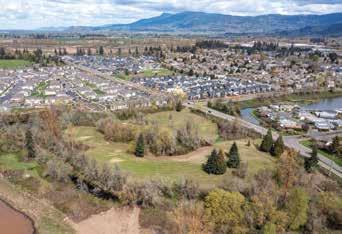
Acquiring and developing new parkland is a major goal of the 30-year Parks and Recreation System Plan and crosses multiple fiscal years. In FY22 progress was made on several acquisitions including Antis Oaks and Osprey Hollow.
Antis Oaks – This site will provide a major Ridgeline trailhead for southwest Eugene, connecting existing public lands with expanded parking options. Work began to stabilize the site through fencing and habitat restoration.
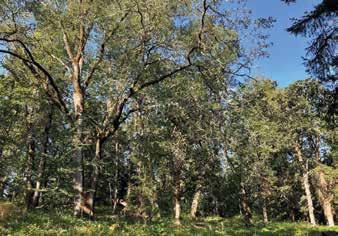
Osprey Hollow – As northeast Eugene’s newest neighborhood park and formerly the three southernmost holes of the RiverRidge Golf Course, Osprey Hollow features mature trees, remnant sloughs, naturalized greens and a loop footpath with three pedestrian bridges.

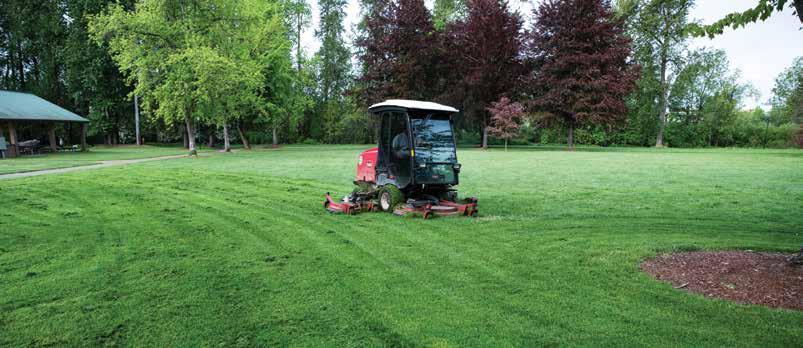
Our 44 full-time and 30 seasonal operations staff maintain park assets while creating a safe and welcoming environment. Mowing grass, emptying trash, cleaning restrooms, monitoring playground safety, repairing irrigation, and removing leaves are all part of a day’s work. Trail building and maintenance, invasive species control, habitat improvements, roadside and waterway pruning, graffiti removal and cleanup of urban campsites complete the daily round.
“Our family is a frequent user of Eugene parks. We appreciate the efforts of the city to clean and restore the parks to safe, clean and beautiful areas in which families may recreate. Parks increase livability in urban areas. Parks are, economically speaking, a positive externality.” — Survey Comment
route checks in developed parks (bathroom, sanitation, trash removal and safety checks) 454 custodial visits to high-use natural areas and trailheads
1,298
times turf was mowed 1,278 playground inspections 14 miles of gravel and bark trails resurfaced
1,009
trees watered during establishment cycle 345 invasive species control projects
irrigation site inspections and repairs 574 instances of tree pruning and landscape maintenance
Nearly two million dollars of capital funds in FY22 were used to repair park sidewalks, complete fencing and gate repairs, renovate playground equipment, and provide tennis court overlays.
Amazon Headwaters Trail widening phase 1 – Phase one of a trail widening project on the lower half of the Amazon Headwaters trail was completed in summer of 2022. Newly installed retaining walls stabilize the trail’s downhill edge and create a four-foot wide trail that hikers, runners and bikers can safely share.
• Whiteaker Community Garden fence replacement
• Path renovation and replacement in Alton Baker, Skinner Butte and Amazon Parks

• Washington Park tennis court resurfacing
• Turf field replacements in partnership with 4J

With the additional five years of support from the 2018 Operational Levy, Parks staff have been able to improve park safety, keep restrooms open, increase daily services to parks, service new garbage cans, portable restrooms and picnic tables, revitalize trails and trailheads, care for new parks such as the Downtown Riverfront Park, and more. As new bond projects have been completed and transition to park operations stewardship, levy funds will guarantee their maintenance through 2023.
of respondents feel that the changes made possible by the levy were completely or mostly worth the expense.
In addition to two full-time and two seasonal park ambassadors, in FY22 Parks hired a third temporary park ambassador focused on the new Downtown Riverfront Park as well as an overnight security presence for the park. Park ambassadors provide a welcoming presence in parks and remind people of park rules. Two dedicated, full-time Eugene Police park resource officers remain focused on increasing park safety and presence. Together this team also works to ensure our parks, natural areas and waterways remain free of garbage and hazardous waste. of respondents say that camping or concerns about safety prevent them from visiting Eugene parks.
Added two year-round Eugene Police Officers dedicated to patrolling parks
Added two year-round and two seasonal Park Ambassadors
Expanded Cleanup Response Team to provide daily clean-up operations
Increased graffiti removal response from monthly to weekly
Park Maintenance: Reopened closed restrooms
Visiting more parks daily for increased custodial services during summer
Increased mowing frequency
Added preventative tree maintenance in developed parks

Added preventative maintenance of irrigation, lighting and park furnishings
Added seasonal weekend and after-hours maintenance in high-use parks
Increased seasonal trash service to several times a week at high use trailheads
Added preventative maintenance of roads, parking areas, fences, signs and portable restrooms
Continuing vegetation management to reduce fuel loads, manage weeds and add native plants
Increased trail maintenance
of respondents who said they feel safer in parks this year attributed it to seeing fewer people camping in parks, 53% attributed it to less litter and 51% attributed it to less evidence of drug use.

A key component of the 30-year System Plan identifies the need to secure sustainable funding to maintain existing parks and allow for future growth, while further improving security and reducing illicit activities. Current safety initiatives and parks maintenance funded by the 2018 Operational Levy will end in 2023 without a renewed source of funding.
of park survey respondents feel that funding parks to improve safety, accessibility, usability and attractiveness is extremely or very important.

“Public parks are one of the only ways many people are able to experience nature on a regular basis. They are important for community building, mental and physical health, and provide access to resources such as exposure to different people and cultures, recreational activities, dog parks, and more.”
— Survey Comment
Park staff also care for a robust network of green infrastructure features located in the urban right-of-way. Rain gardens, medians and street trees connect our green spaces, treat stormwater, reduce flooding and improve air quality.
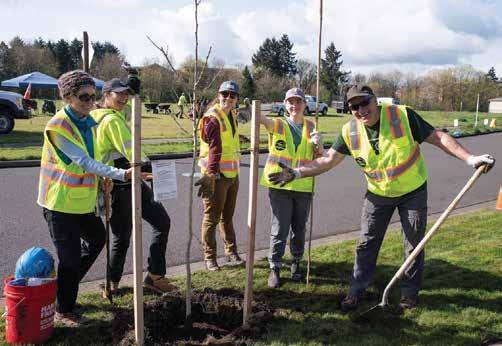
Our urban canopy includes 65,000 street trees, 6,600 trees in developed parks and tens of thousands more in natural areas, all working to clean our air, cool our city, clean our water, and provide shady enjoyment for many.
Parks staff care for a combined 5,000+ acres throughout Eugene. Far beyond recreation, parklands and waterways provide ecosystem services that make Eugene a healthier place to live, work and play. 32 Eugene Parks and Open Space Volunteer tree planting at Chase Commons Gillespie Butte
Gillespie Butte
As part of the City of Eugene’s Climate Action Plan 2.0, new plantings to meet the ambitious goal of increasing canopy cover to 30% from 22% by 2030 are underway. These newly planted trees require 3 years of establishment care and watering, followed by preventative pruning cycles, to maintain health and extend the environmental benefits of a healthy and mature urban forest.
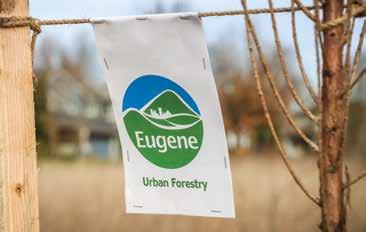
street trees pruned
pruning cycle
In FY22, City Council directed $50,000 annually towards increased street tree planting to meet environmental and social equity goals. With the help of volunteers and the non-profit Friends of Trees, our Urban Forestry team planted more than 600 new street trees in the Hwy 99 corridor, Chase Commons and the downtown core. Further, two concrete removal projects completed in partnership with Public Works Engineering made space for an additional 19 new street trees.
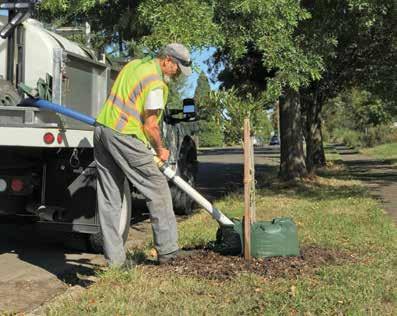
Higher rates of tree canopy cover have been shown to increase community health outcomes. Park staff prioritize planting locations using the Society of American Foresters Tree Equity and tree plotter canopy analysis tools which combine data such as low canopy cover with percentages of people living in poverty. Focused park and street tree plantings in these historically underserved areas enhance community livability while adding to overall city canopy cover.
street trees planted
park and natural area trees planted
60 miles of critical waterways in parks are managed for habitat and recreation opportunities. Staff steward these rivers and creeks through bank stabilization activities, invasive species removal, trash cleanup, wildlife habitat protection and much more.


‘Green Piping’ teams annually prune waterways vegetation growth to allow for improved stormwater conveyance (flow) while maintaining a shady canopy that reduces water temperatures and provides critical habitat.
Years of efforts to improve conditions at Golden Gardens ponds in north Eugene, and protect Northwestern Pond Turtle nests from predators have paid off.

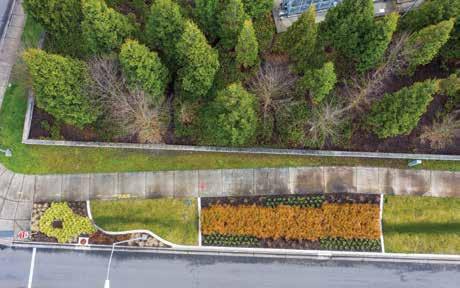
City-maintained rain gardens, or vegetated stormwater facilities, slow runoff water and absorb pollutants before it enters our rivers and streams. Based on the FY22 annual assessment of 468 public rain gardens, 260 were found to be in excellent or good condition, 107 rated poor or very poor, and the remainder in fair condition. Continued accelerated growth of the public and private vegetated stormwater system is expected, with an additional 20% growth in public and 10% growth in private facilities in the next year.
Medians clean our air, filter our water, and reduce stormwater runoff; as if that isn’t enough, in creating a buffer between streets they relieve pedestrian stress, calm traffic and beautify the city. Parks staff perform ongoing maintenance and ensure vision clearance of 201 vegetated medians. In FY22, 28 in-house renovations were completed of existing medians to enhance the landscape and extend their life cycle.
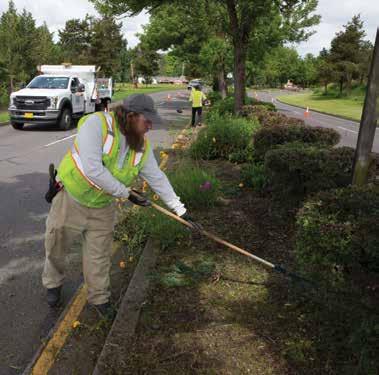 36 Eugene Parks and Open Space
36 Eugene Parks and Open Space
Eugene’s 4,255 acres of natural area parks include Douglas fir-dominated ridgelines, rolling oak woodlands and prairies, wetlands, streams and the Willamette River. All provide opportunities to connect with nature, recreate and relax.
Supporting these ecosystems helps provide critical wildlife habitat, protects and enhances water and air quality, sequesters carbon and provides ample recreational opportunities.
“I walk the river trail and ridgeline trails a lot and very much appreciate having them available and well maintained. Really serves the citizens of Eugene well!”
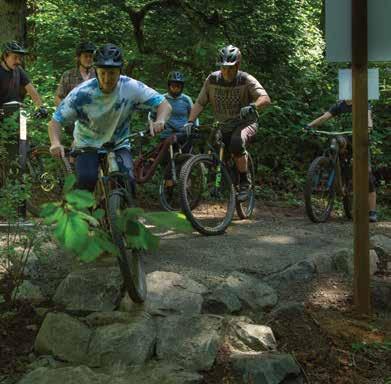
Located within our higher density neighborhoods and frequently adjacent to developed parks, neighborhood natural areas are managed to provide refuges for wildlife, connect green spaces, and offer a bit of the wild for the city-dweller.

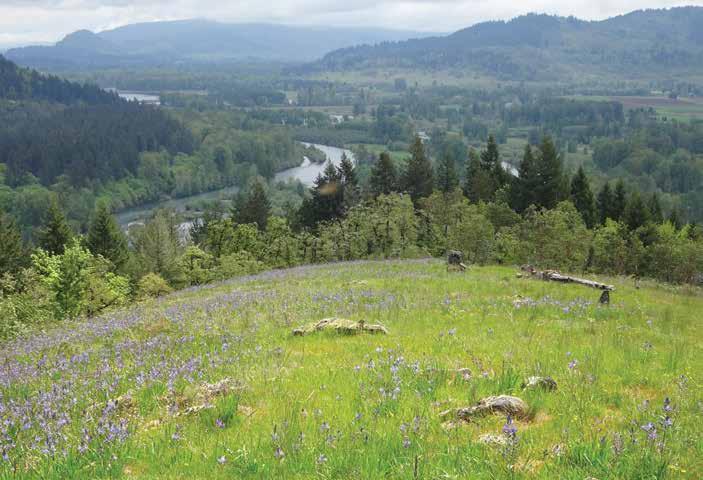
Fuels reduction treatments increase public safety, enhance habitat, and improve opportunities for public access. Projects focused on removal of blackberry thickets and pockets of small invasive trees near homes, schools, businesses and trail intersections. This important work is funded through the Bureau of Land Management Community Wildfire Assistance Program and City capital funding.
In 2003, a wide range of local and regional governments and local environmental groups unanimously supported the vision of collaboratively advancing protection, restoration, and management of lands in the southern Willamette Valley. Today, the 19 partners are celebrating 20 years and have begun looking forward to craft a new vision with new projects to meet the changing needs of our community.
38 Eugene Parks and Open Space Coryell Ridge looking toward Mt. Pisgah, Dorris Ranch, Glassbar Island and the Confluence (River to Ridges partner lands)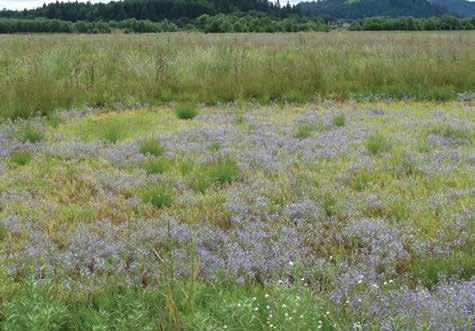
The Coyote Prairie North mitigation bank continues to provide compensatory mitigation for approved removal/fill projects with just a handful of credits remaining. Previous restoration work has generated 77 credits, and after these last few credits have been sold the site will continue to be maintained under an approved Long-Term Management Plan. Future mitigation for impacts to wetlands will be provided by the new Amazon Prairie mitigation bank.
Parks just completed its fifth year as a Salmon-Safe certified parks and natural area agency. Salmon-Safe is a nongovernmental organization that offers peer-reviewed certification connecting land management and development practices with watershed health. This year, we completed an identification of stormwater treatment options at our operations yard and continue to monitor and report on water use and pesticide use in parks. In addition, all new park designs and renovations are reviewed by SalmonSafe staff for compliance with their guiding principles.

eugene-or.gov/parks
 Maurie Jacobs Park
Maurie Jacobs Park